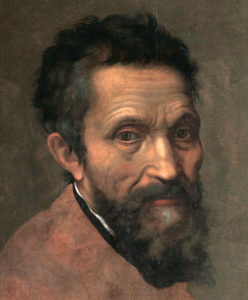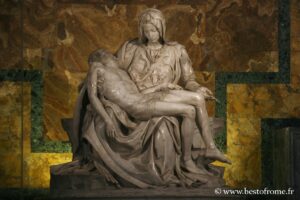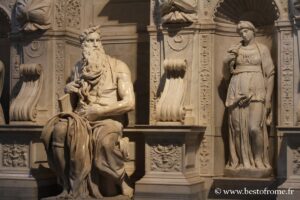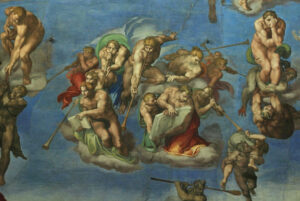The Renaissance Artist and His Unique Style
Michelangelo, an iconic figure of the Renaissance, born on March 6, 1475, in Caprese, Tuscany, and died on February 18, 1564, in Rome, was a versatile artist whose career and style continue to inspire. A sculptor, painter, architect, poet, and urban planner, many of his works are considered major masterpieces of the Renaissance. He enjoyed great recognition during his lifetime.
His full name, Michelangelo di Lodovico Buonarroti Simoni, reflects his Florentine origins, where he grew up after the untimely death of his mother at the age of six, raised by his father and uncles.
At 13, he was apprenticed to Domenico Ghirlandaio, a Florentine painter, but his passion for sculpture led him to abandon this apprenticeship to focus on it. Under the patronage of Lorenzo de’ Medici, he studied ancient Greek and Roman sculptures and deepened his knowledge of anatomy, which were fundamental in shaping his artistic style.
Michelangelo’s style is distinguished by emotional intensity and physical realism, with muscular, heroic figures captured in dynamic poses, often using contrapposto, where the body’s weight is shifted to suggest movement. His early works, such as the Pietà, display classical harmony, while his later works, like the Last Judgment, evolve toward Mannerism, with elongated figures and complex compositions. His art influenced artists such as Bernini and Caravaggio.
Career and Major Works of Michelangelo
His rich and diverse career includes sculptural, pictorial, and architectural works. Arriving in Rome in 1496, he sculpted the Bacchus for Cardinal Riario, marking his Roman debut. His first major Roman work, the Pietà (1498-1499), located in the Basilica of Saint Peter, depicts the Virgin Mary holding the body of Christ after the crucifixion, renowned for its tenderness and realism. The David (1504), originally placed in front of the Palazzo Vecchio in Florence (now in the Galleria dell’Accademia), symbolizes the strength and independence of Florence, standing 5.17 meters tall in marble. It demonstrates his mastery of anatomy and expressiveness.
The Moses (1515), created for the Tomb of Julius II in the Basilica of Saint Peter in Chains in Rome, also illustrates the power of his sculptures and his anatomical precision.
In Rome, he transformed the Sistine Chapel with the ceiling (1508-1512), commissioned by Pope Julius II, depicting scenes from Genesis, including the iconic “Creation of Adam,” surrounded by lunettes representing Christ’s ancestors. The Last Judgment (1536-1541), on the altar wall, with Christ and numerous figures, was controversial for its nudity. In architecture, appointed chief architect of Saint Peter’s Basilica in 1547, he redesigned the dome, completed in 1590 by Giacomo della Porta, influencing domes like that of Saint Paul’s in London. He redesigned the Capitoline Square with a symmetrical space and new palaces and designed the classical Porta Pia (1561-1564) in the Aurelian Walls.
Personal Life, Poetry, and Legacy
Michelangelo, known for his perfectionism and fiery temperament, often worked alone, sometimes destroying unsatisfactory works. He never married but maintained significant relationships, notably with Tommaso de Cavalieri, to whom he addressed affectionate letters and sonnets. His deep Christian faith imbued his art, especially in his later works. A prolific poet, he wrote over 300 sonnets and madrigals, exploring love, spirituality, and his artistic struggles, often inspired by his friendship with Vittoria Colonna, a poetess with whom he corresponded.
His influence on Western art is immense, considered one of the greatest artists of all time, alongside Leonardo da Vinci and Raphael, forming the “three divine artists” of the Renaissance. His anatomical studies and realism set new standards, inspiring generations of artists. His works are largely preserved in prestigious museums like the Louvre.
Michelangelo’s Architectural Works in Rome
- Saint Peter’s Basilica (dome), Vatican, Rome. Michelangelo worked from 1547 to 1564 on the design, with the dome completed in 1590 by Giacomo della Porta.
- Cordonata capitolina (staircase leading to the Capitoline Square)
- Capitoline Square, 1536-1546, includes the facades of the Palazzo dei Conservatori and Palazzo Senatorio.
- Palazzo Farnese (2nd floor), After 1546
- Church of San Giovanni Battista dei Fiorentini (unrealized projects), 1559–1560
- Basilica of Santa Maria Maggiore, Sforza Chapel, circa 1560
- Porta Pia, 1561–1565
- Basilica of Santa Maria degli Angeli e dei Martiri, 1561
Works, Sculptures
Pietà, 1499–1500, Saint Peter’s Basilica, Rome, Marble (height: 174 cm, width at base: 195 cm)
The Pietà is displayed in a chapel to the right of the entrance of Saint Peter’s Basilica. It depicts the Virgin Mary holding the body of Christ after the Crucifixion. It is one of the most famous works of art in the world, securing Michelangelo’s fame. It was originally commissioned by the French cardinal Jean Bilhères de Lagraulas, abbot of Saint-Denis Basilica, French ambassador to the Pope. It was intended to adorn the funerary monument in memory of the late King Charles VIII (died in April 1498) in the Santa Petronilla chapel (the chapel of the kings of France) of the old Saint Peter’s Basilica. Michelangelo chose a block of Carrara marble, cream-colored. He reportedly worked twenty hours a day to meet the contract deadline, using a chisel, hammer, and pumice stone. In May 1972, a disturbed individual damaged the sculpture with hammer blows, breaking the Virgin’s nose and part of her arm. It has since been restored. The restoration revealed Michelangelo’s monogram on the Virgin’s left hand, an “M” drawn on the palm.- In the Basilica of Saint Peter in Chains:
- Tomb of Julius II, 1503
Moses, circa 1513–1515, Tomb of Julius II, Marble (height: 235 cm).
The statue of Moses is integrated into the Tomb of Julius II, originally intended to adorn Saint Peter’s Basilica in Rome. It depicts Moses, descending from Sinai with the Tablets of the Law, looking angrily at the Jews worshipping the golden calf. It was meant to be placed on the top tier of the tomb.
Moses is depicted with horns, which has sparked debate, between interpretations linked to spiritual radiance and a possible misinterpretation of biblical texts.- Rachel, 1545, Marble (height: 197 cm)
- Leah, 1545, Marble (height: 209 cm)
- Christ of the Minerva (Risen Christ), 1519–1520, Church of Santa Maria sopra Minerva. Marble (height: 205 cm)
Works, Paintings
In the Sistine Chapel, Vatican, Rome
- The Ceiling, 1508–1512, Fresco
- The Last Judgment, 1536–1541, Fresco 1370 × 1220 cm
- The Creation of Adam, 1508–1512, Fresco 480 × 230 cm
- The Drunkenness of Noah, 1509, Fresco 539 × 340 cm
- In the Pauline Chapel, Vatican, Rome.
- Martyrdom of Saint Peter, 1542–1550, Fresco 625 × 662 cm
- Conversion of Saint Paul, 1542–1550
Michelangelo Itinerary in Rome: Map
If you see this after your page is loaded completely, leafletJS files are missing.













